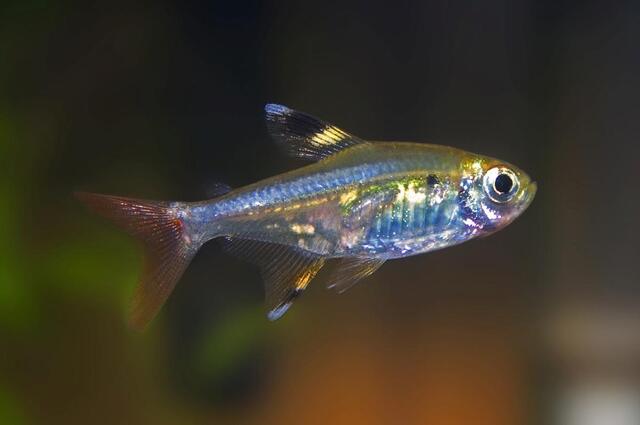Among the rich and diverse creatures on Earth, there are some animals that begin with the letter "X" that are extremely rare and fascinating. Among them, the most representative is the X-ray fish (scientific name: Pristella maxillaris) . This amazing freshwater fish is known for its transparent body, which allows us to glimpse its internal structure as if it were exposed to "X-rays". This article will take a deep look at the characteristics of the X-ray fish, its living habits, its habitat, and its popularity among aquarium hobbyists.
The X-ray fish, also known as the transparent characin, belongs to the family Characidae and is native to the Amazon River Basin in South America. They are named after their transparent body structure, which allows their internal organs and bone structure to be clearly seen with the naked eye, just like being exposed to X-rays. The transparent body of X-ray fish not only makes them look unique in nature, but also provides natural samples for scientists to study the physiological structure of fish.

The body of X-ray fish is translucent, the main color of the body is silver, and the bones and organs inside the body are faintly visible under sunlight or light. They are usually small in size, and the body length of adult fish is about 3 to 5 cm. Despite their small size, X-ray fish often have yellow and black markings on their tail fins, making them look very agile in the water.
X-ray fish are gregarious fish that like to live in groups with their own kind. They are gentle in nature, so they are very suitable for mixed breeding with other small freshwater fish. X-ray fish like to swim in warm, slow-flowing waters, usually in the middle and lower layers of the water body. They feed on small invertebrates, algae and other plankton, and are omnivorous fish.
X-ray fish are native to the Amazon River Basin in South America, especially the freshwater rivers, lakes and swamps in Venezuela and Guyana. They like to live in an environment with clear water and lush vegetation, and are highly adaptable and can survive in different water temperatures and water quality conditions.
In the natural environment, X-ray fish use their transparent bodies as a defense mechanism to avoid being caught by predators. Because their bodies can blend well with the water environment, they reduce the chance of being discovered by natural enemies. This "invisible" characteristic allows them to survive in highly competitive rivers and lakes.
X-ray fish are oviparous fish. Female and male fish breed in waters rich in aquatic plants, usually laying hundreds of eggs at a time. These eggs hatch in 24 to 36 hours, and the young fish will begin to swim freely and forage within a few days. X-ray fish are relatively easy to breed and are suitable for aquarium enthusiasts to breed in their home aquariums.
As ornamental fish, X-ray fish are very popular because they are not only unique in appearance but also easy to care for. When breeding X-ray fish, the water temperature of the aquarium should be kept between 22°C and 28°C, and proper water flow and oxygen supply should be maintained. In addition, they have relatively low requirements for water quality, just keep the water clean and change the water regularly.
The diet of X-ray fish is relatively simple, and they can be fed with ordinary fish feed, frozen food, or small plankton. As a social fish, it is recommended to keep at least 6 or more X-ray fish in the aquarium, so that they will appear more active and show natural group behavior.
X-ray fish are highly respected in the ornamental fish world, not only because of their unique appearance, but also because they are easy to keep, gentle, and can live in harmony with other freshwater fish. In addition, the small size and low-key color of X-ray fish make them an ideal choice for aquariums of all sizes.
1. Unique transparent appearance
Their translucent appearance is a miracle in nature, and the bones and internal organs can be observed through the fish body, which makes X-ray fish a highlight in the aquarium.
2. Gentle temperament
X-ray fish have a gentle personality and are suitable for mixed breeding with other small fish with similar temperaments, such as neon tetras, zebra fish, etc., and will not conflict with other fish.
3. Easy to breed
For aquarium enthusiasts, the breeding of X-ray fish is relatively simple, and only the appropriate aquatic plants and water quality environment can help them breed smoothly.
Although the population of X-ray fish in nature is relatively stable, their habitat - freshwater wetlands in the Amazon River Basin - is threatened by environmental pollution, deforestation and climate change. The destruction of wetlands may affect X-ray fish and other species that rely on this ecosystem for survival. Therefore, protecting wetlands and river environments is one of the important measures to ensure the survival of X-ray fish.
As a unique freshwater fish, X-ray fish is not only widely concerned for its transparent appearance and magical body structure, but also for its docile temperament and easy-to-raise characteristics, making it a favorite of aquarium enthusiasts. However, with global environmental changes and habitat destruction, the living environment of X-ray fish faces potential threats. By paying attention to environmental issues and protecting natural ecosystems, we can ensure that this amazing species continues to exist on Earth.